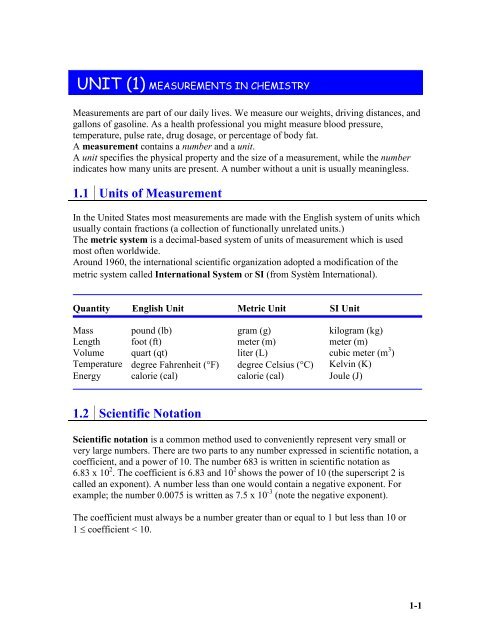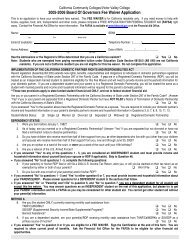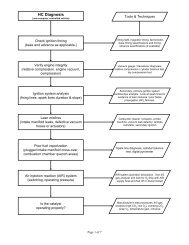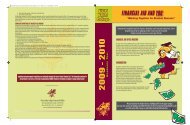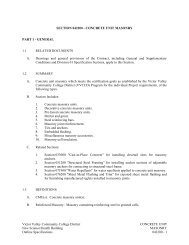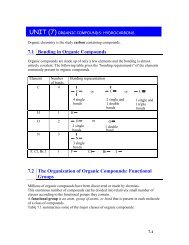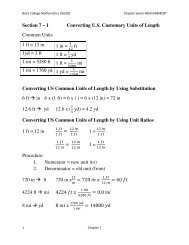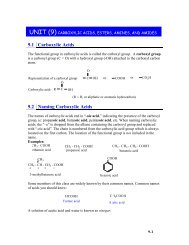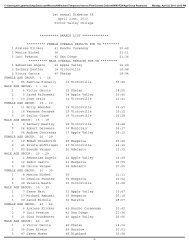unit (1) measurements in chemistry
unit (1) measurements in chemistry
unit (1) measurements in chemistry
- No tags were found...
You also want an ePaper? Increase the reach of your titles
YUMPU automatically turns print PDFs into web optimized ePapers that Google loves.
Practice 1-3Give the metric prefix that corresponds to each of the follow<strong>in</strong>ga) 1,000,000,000 b) 10 -6 c) 1000 d) 0.01 e) 10 -9 f)10 12Answera) giga b) micro c) kilod) centi e) nano f) tera1.4 Significant Figures <strong>in</strong> MeasurementsA student is asked to determ<strong>in</strong>e the mass of a small object us<strong>in</strong>g two different balancesavailable <strong>in</strong> the lab. The lower priced model reports masses to with<strong>in</strong> ±0.01 g (one-onehundredth), while the higher priced one reports to with<strong>in</strong> ±0.0001 g (one-ten thousandth).The student measures the mass three times on each balance and completes the follow<strong>in</strong>gtable.First balanceSecond balanceThree <strong>measurements</strong> 2.16, 2.14, 2.15 g 2.1538, 2.1539, 2.1537 gAverage 2.15 g 2.1538 gReproducibility ±0.01 g ±0.0001 gWhich digit is the “uncerta<strong>in</strong>digit” <strong>in</strong> the average?Which digits are “certa<strong>in</strong>digits” <strong>in</strong> the average?How many significant digitsare <strong>in</strong> the average?The last digit; 5 The last digit; 82, 1 2, 1, 5, 3Three significant digits Five significant digitsSignificant figures (sig figs) are the digits that are known with certa<strong>in</strong>ty plus one digitthat is uncerta<strong>in</strong>. All nonzero digits <strong>in</strong> <strong>measurements</strong> are always significant.Are zeroes significant?YES: zeros between nonzero digits (20509).YES: zeros at the end of a number when a decimal po<strong>in</strong>t is written (3600.).NO: zeros at the end of a number when no decimal po<strong>in</strong>t is written (3600).NO: zeros at the beg<strong>in</strong>n<strong>in</strong>g of a number (0.0047).1-4
Worked Example 1-2How many significant figures does each number have?a) 0.0037 b) 600. c) 93,000d) 2.08 x 10 -5 e) 600 f) 58.00g) 4010049 h) 1.700 x 10 2 i) 4.0100 x 10 6Solutionsf sf sf0.0037 2 600. 3 93,000 22.08 x 10 -5 3 600 1 58.00 44010049 7 1.700 x 10 2 4 4.0100 x 10 6 5Significant Figures <strong>in</strong> “Exact Numbers”Exact numbers have an unlimited number of significant figures. Exact numbers areobta<strong>in</strong>ed by count<strong>in</strong>g items or by def<strong>in</strong>ition.Count<strong>in</strong>g: 24 students mean 24.0000000… students. 8 pennies means 8.0000... pennies.Def<strong>in</strong>ition: 1 m = 100 cm means 1.00000….m = 100.000000….cm1.5 Calculations Involv<strong>in</strong>g Significant FiguresRules for Round<strong>in</strong>g off NumbersIf the first digit to be deleted is 4 or less, leave the last reported digit unchanged.If the first digit to be deleted is 5 or greater, <strong>in</strong>crease the last reported digit by one.In some cases you need to add significant zeros. The number 2, reported <strong>in</strong> foursignificant figures, is 2.000.Practice 1-4Round off each of the follow<strong>in</strong>g to three significant figures.a) 9.174 b) 9.175 c) 9.176d) 5 e) 0.0040 f) 8000g) 2.4 x 10 -5 h) 670Answera) 9.174 (9.17) b) 9.175 (9.18) c) 9.176 (9.18)d) 5 (5.00) e) 0.0040 (0.00400) f) 8000 (8.00 x 10 3 )g) 2.4 x 10 -5 (2.40 x 10 -5 ) h) 670 (670.)1-5
Rules for Round<strong>in</strong>g off <strong>in</strong> CalculationsA. Multiplication and DivisionThe answer carries the same number of significant figures as the factor with the fewestsignificant figures.Practice 1-5Perform each of the follow<strong>in</strong>g calculations to the correct number of significantfigures.a) 33.56 x 1.9483 b) (2.50 x 10 -3 ) x (1.8500 x 10 5 )c) 47.5301 ÷ 2.30 d) (6.56 x 10 10 ) ÷ (7.8 x 10 9 )Answera) 33.56 x 1.9483 = 65.38 b) (2.50 x 10 -3 ) x (1.8500 x 10 5 ) = 4.63 x 10 2c) 47.5301 ÷ 2.30 = 20.7 d) (6.56 x 10 10 ) ÷ (7.8 x 10 9 ) = 8.4B. Addition and SubtractionThe answer should have the same number of decimal places as the quantity with thefewest decimal places.Practice 1-6Perform each of the follow<strong>in</strong>g calculations to the correct number of significantfigures:a) 73.498 + 2.2 b) 63.81 + 205.4c) 191.000 - 188.0 d) 124.08 - 39.1740e) (6.8 x 10 -2 ) + (2.04 x 10 -2 ) f) (5.77 x 10 -4 ) - (3.6 x 10 -4 )Answera) 73.498 + 2.2 = 75.7 b) 63.81 + 205.4 = 269.2c) 191.000 - 188.0 = 3.0 d) 124.08 - 39.1740 = 84.91e) (6.8 x 10 -2 ) + (2.04 x 10 -2 ) =8.8 x 10 -2 f) (5.77 x 10 -4 ) - (3.6 x 10 -4 ) =2.2 x 10 -41-6
1.6 Writ<strong>in</strong>g Conversion FactorsMany problems <strong>in</strong> <strong>chemistry</strong> require convert<strong>in</strong>g a quantity from one <strong>unit</strong> to another. Toperform this conversion, you must use a conversion factor or series of conversion factorsthat relate two <strong>unit</strong>s. This method is called dimensional analysis.Any equality can be written <strong>in</strong> the form of a fraction called a conversion factor. Aconversion factor is easily dist<strong>in</strong>guished from all other numbers because it is always afraction that conta<strong>in</strong>s different <strong>unit</strong>s <strong>in</strong> the numerator and denom<strong>in</strong>ator.Convert<strong>in</strong>g kilograms to pounds can be performed us<strong>in</strong>g the equality 1 kg = 2.20 lb. Thetwo different conversion factors that may be written for the equality are shown below.Note the different <strong>unit</strong>s <strong>in</strong> the numerator and denom<strong>in</strong>ator, a requirement for allconversion factors.Conversion Factors:NumeratorDenom<strong>in</strong>ator1kg2.20 lbor2.20 lb1kgSome common <strong>unit</strong>s and their equivalents are listed <strong>in</strong> Table 1.1. You should be able touse the <strong>in</strong>formation, but you will not be responsible for memoriz<strong>in</strong>g the table. The Tablewill be given to you dur<strong>in</strong>g quizzes and exams.Table 1.1 Some Common Units and Their EquivalentsLength 1 m = 100 cm 1 m = 1000 mm 1 cm = 10 mm 1 km = 1000 m 1nm = 10 -9 m1Å = 10 -10 m 1 <strong>in</strong> = 2.54 cm 1 ft = 30.48 cm 1 mi = 1.61 km 1 yd = 0.91 m1 ft = 12 <strong>in</strong>.Mass 1 kg = 1000 g 1 g = 1000 mg 1 lb = 454 g 1kg = 2.20 lb 1 oz = 28.35 g1 lb = 16 ozVolume 1L = 1000 mL 1 mL = 1 cm 3 1qt = 0.946 L 1 gal = 3.78 LEnergy1 cal = 4.18 JTemperature ˚F = 1.8˚C + 32 ˚C = (˚F -32)/1.8 K = ˚C + 273.151-7
Worked Example 1-3Write conversion factors for each of the follow<strong>in</strong>g equalities or statements:a) 1 g = 1000 mg b) 1 foot = 12 <strong>in</strong>chesc) 1 quart = 0.946 liter d) The accepted toxic dose ofmercury is 0.30 mg per day.SolutionEquality Conversion factor Conversion factor1g1000 mg1 g = 1000 mg 1000 mg1g1ft1 foot = 12 <strong>in</strong>ches 12 <strong>in</strong>.1qt1 quart = 0.946 liter 0.946 L12 <strong>in</strong>.1ft0.946 L1qtThe accepted toxic dose ofmercury is 0.30 mg per day.0.30 mg1day1day0.30 mg1.7 Problem Solv<strong>in</strong>g <strong>in</strong> Chemistry - Dimensional AnalysisDimensional analysis is a general method for solv<strong>in</strong>g numerical problems <strong>in</strong> <strong>chemistry</strong>.In this method we follow the rule that when multiply<strong>in</strong>g or divid<strong>in</strong>g numbers, we mustalso multiply or divide <strong>unit</strong>s.Solv<strong>in</strong>g problems by dimensional analysis is a three-step process.1. Write down the given measurement; number with <strong>unit</strong>s.2. Multiply the measurement by one or more conversion factors. The <strong>unit</strong> <strong>in</strong> eachdenom<strong>in</strong>ator must cancel (match) the preced<strong>in</strong>g <strong>unit</strong> <strong>in</strong> each numerator.3. Perform the calculation and report the answer to the proper significant figures basedon numbers given <strong>in</strong> the question (data), not conversion factors used.1-8
Worked Example 1-4Convert 0.455 km to meters.SolutionTo convert kilometers to meters, we could use the follow<strong>in</strong>g equality:1 km = 1000 m (See Table 1.1)The correspond<strong>in</strong>g conversion factors would be:1 kmand1000 m1000 m 1 kmWe select the conversion factor to cancel kilometers, leav<strong>in</strong>g <strong>unit</strong>s of meters.1000 m0.455 km x = 455 m1 kmThe number of significant figures <strong>in</strong> your answer reflect 0.455 km. The exactconversion factor does not limit the number of significant figures <strong>in</strong> your answer.Worked Example 1-5Convert 4.5 weeks to m<strong>in</strong>utes.Solution4.5 wk x7 d1 wkx24 h1 dx60 m<strong>in</strong>1 h= 45000 m<strong>in</strong>(45360 rounded to 2 sig figs.)Worked Example 1-6Convert 2.7 g/mL to lb/L.SolutionWe need two conversion factors. One to convert g to lb and the other to convertmL to L. We know that 1 lb= 454 g and 1 L = 1000 mL (See Table 1.1)2.7 g1.0 mLx1 lb454 gx1000 mL1 L= 5.9 lb/LRemember that the number of significant figures <strong>in</strong> your answer reflect 2.7. Theconversion factors do not limit the number of significant figures <strong>in</strong> your answer.1-9
Practice 1-7Perform each of the follow<strong>in</strong>g conversions:a) Convert 14.7 lb to ounces. b) Convert 19.8 lb to kilograms.c) Convert 23 m/sec to mi/hr.AnswerConversionConvert14.7 lb toouncesConvert19.8 lb tokilogramsConvert 23m/sec tomi/hr.Calculation14.7 lb x16 oz1 lb= 235 oz1 kg19.8 lb x2.20 lb= 9.00 kg23 m 1 km 1.0 mi 3600 secx xx1.0 sec 1000 m 1.61 km 1 hr= 51mihr1.8 Density and Specific GravityDensity is the ratio of the mass of a substance to the volume occupied by that substance.density=mass of substanceor dvolume of substance=mVDensity is expressed <strong>in</strong> different <strong>unit</strong>s depend<strong>in</strong>g on the phase (form) of the substance.Solids are usually expressed <strong>in</strong> grams per cubic centimeter (g/cm 3 ), while liquids arecommonly grams per milliliter (g/mL). The density of gases is usually expressed asgrams per liter (g/L).1-10
Worked Example 1-7If 10.4 mL of a liquid has a mass of 9.142 g, what is its density?Solutiond=mVd=9.142 g10.4 mL= 0.879 g/mLDensity can be used as a conversion factor that relates mass and volume, note thedifferent <strong>unit</strong>s <strong>in</strong> the numerator and denom<strong>in</strong>ator. Densities can be used to calculate massif volume is given or calculate volume given mass. For example, we can write twoconversion factors for a given density of 1.05 g/mL:1.05 g1.00 mLor1.00 mL1.05 gWorked Example 1-8The density of a sal<strong>in</strong>e solution is 1.05 g/mL. Calculate the mass of a 377.0 mLsample.Solutiond=mVm= 377.0 mL x1.05 g1.00 mL = 396 gPractice 1-8The density of rubb<strong>in</strong>g alcohol is 0.786 g/mL. What volume of rubb<strong>in</strong>g alcoholwould you use if you needed 32.0 g?AnswerWe use the density as a conversion factor:V= 32.0 g x1.00 mL0.786 g= 40.7 mL1-11
Specific Gravity is the ratio of the density of liquid to the density of water at 4°C,which is 1.00 g/mL. S<strong>in</strong>ce specific gravity is a ratio of two densities, the <strong>unit</strong>s cancel.specific gravitydensity of sample (g/mL)=density of water (g/mL)(No <strong>unit</strong>s)An <strong>in</strong>strument called a hydrometer is used to measure the specific gravity of liquids.Worked Example 1-9What is the specific gravity of jet fuel if the density is 0.775 g/mL?Solutionspecific gravity0.775 g/mL= = 0.7751.00 g/mLPractice 1-9A 50.0 mL sample of blood has a mass of 53.2 g.a) Calculate the density of the blood.b) Calculate the specific gravity of the blood.Answerd=mVa) d =53.2 g50.0 mL =1.06 g/mLspecific gravity =density of blooddensity of water=1.06 g/mL1.00 g/mL= 1.061-12
1.9 Temperature ScalesTemperature, reported <strong>in</strong> Fahrenheit (°F) or Celsius (°C), is used to <strong>in</strong>dicate how hot orcold an object is. The SI <strong>unit</strong> for report<strong>in</strong>g temperature is Kelv<strong>in</strong> (K).See the comparison of the three scales:Freez<strong>in</strong>g po<strong>in</strong>t Boil<strong>in</strong>g po<strong>in</strong>t Normal bodyof water of water temperatureFahrenheit 32°F 212°F 98.6°FCelsius 0°C 100°C 37°CKelv<strong>in</strong> 273 K 373 K 310 KThe follow<strong>in</strong>g formulas show the conversions:Fahrenheit to Celsius: °C =(°F - 32)1.8Celsius to Fahrenheit: °F = 1.8 °C + 32Celsius to Kelv<strong>in</strong>: K = °C + 273Practice 1-10Complete the follow<strong>in</strong>g table.AnswerFahrenheit Celsius Kelv<strong>in</strong>88°F-55°C469KFahrenheit Celsius Kelv<strong>in</strong>88°F 31°C 304 K-67°F -55°C 218 K385°F 196°C 469 K1-13
1.10 Heat and Specific HeatHeat and temperature are both a measure of energy. Heat, however, is not the same astemperature. Heat measures the total energy, whereas temperature measures theaverage energy. A gallon of hot water at 200°F has much more heat energy than ateaspoon of hot water at same temperature.Heat can be measured <strong>in</strong> various <strong>unit</strong>s. The most commonly used <strong>unit</strong> is calorie (cal).The calorie is def<strong>in</strong>ed as the amount of heat required to raise the temperature of 1 gramof water by 1°C. This is a small <strong>unit</strong>, and more often we use kilocalories (kcal).1 kcal = 1000 calNutritionist use the word “Calorie” (with a capital “C”) to mean the same th<strong>in</strong>g askilocalorie.1 Cal = 1000 cal = 1 kcalThe <strong>unit</strong> of energy <strong>in</strong> SI <strong>unit</strong> is joule (pronounced “jool”), which is about four times asbig as the calorie:1 cal = 4.184 JSpecific HeatSubstances change temperature when heated, but not all substances have theirtemperature raised to the same extent when equal amounts of heat are added.Specific Heat is the amount of heat required to raise the temperature of one gram of asubstance by one degree Celsius. It is measured <strong>in</strong> <strong>unit</strong>s of cal/g·°C or J/g·°C.(Recall; 1 cal is required to raise the temperature of 1 gram of water by 1°C, the specificheat of water is therefore: 1.00 cal/g·°C, or 4.184 J/g·°C).Specific heats for some substances <strong>in</strong> various states are listed <strong>in</strong> the follow<strong>in</strong>g table. Asubstance with a high specific heat is capable of absorb<strong>in</strong>g more heat with a smalltemperature change than a substance with lower specific heat.1-14
Specific Heats for Some Common SubstancesSubstanceSpecific Heat (J/g·°C)SolidsLiquidsGasesgold 0.128copper 0.385alum<strong>in</strong>um 0.903ice 2.06mercury 0.138methanol 1.77ethanol 2.42water 4.18argon 0.518oxygen 0.915nitrogen 1.041steam 2.03We can calculate the amount of heat ga<strong>in</strong>ed or lost by a substance us<strong>in</strong>g its specific heat,its measured mass, and the temperature change.Amount of heat = mass x specific heat x change <strong>in</strong> temperature*q = m x SH x (T f<strong>in</strong>al – T <strong>in</strong>itial )* The temperature change could also be written as ∆ (delta T).If any three of the four quantities <strong>in</strong> the equation are known, the fourth quantity can becalculated.Worked Example 1-10Determ<strong>in</strong>e the amount of heat that is required to raise the temperature of 7.400 gof water from 29.0°C to 46.0°C. The specific heat of water is 4.18 J/g.°C.Solutionq = m x SH x ∆Tq = 7.400 g x 4.18 J/g·°C x 17.0°C = 526 J1-15
Practice 1-11What mass of lead is needed to absorb 348 J of heat if the temp of the samplerises from 35.2°C to 78.0°C? The specific heat of lead is 0.129 J/g·°C.Answerq = m x SH x ∆Tso m =qSH x ∆Tm =348 J0.129 J/g°C x 42.8°C= 63.0 gPractice 1-12It takes 87.6 J of heat to raise the temp of 51.0 g of a metal by 3.9°C. Calculatethe specific heat of the metal.Answerq = m x SH x ∆Tso SH =qm x ∆TSH =87.6 J51.0 g x 3.9°C= 0.44 J/g°C1-16
Practice 1-134.00 x 10 3 J of energy is transferred to 56.0 g of water at 19°C. Calculate the f<strong>in</strong>altemperature of water. SH = 4.18 J/g·°C.Answer4.00 x 10 3 J∆T = ------------------------- = 17.1°C56.0 g x 4.18 J/g·°C∆T = T f<strong>in</strong>al - T <strong>in</strong>itial 17.1°C = T f - 19°C T f = 36°C1-17
Homework Problems1.1 Complete the follow<strong>in</strong>g table.Decimal notation Scientific notation Number of significant figures400,0000.00060021,995,0000.050507.28 x 10 33.608 x 10 -59.4090 x 10 41.5 x 10 -31.2 Perform the follow<strong>in</strong>g calculations to correct number of significant figures.a. 4.6 x 0.00300 x 193b. 8.88 ÷ 99.40c. (7.120 x 10 -3 ) ÷ (6.000 x 10 -5 )d. (5.92 x 10 3 ) x 3.87 ÷ 1001.3 Perform the follow<strong>in</strong>g calculations to correct number of significant figures.a. 102 – 5.31 – 0.480b. (3.42 x 10 -4 ) + (5.007 x 10 -4 )c. 7.8 - (8.3 x 10 -2 )d. (3.8 x 10 6 ) - (8.99 x 10 6 )1.4 Perform the follow<strong>in</strong>g conversions. Show your set ups.a. 683 nanometer (nm) to angstrom (Å)b. 520 mi/h to m/secc. 0.714 g/cm 3 to lb/ft 3d. -164°C to °F1.5 What is the density of a metal sample if a15.12-g sample is added <strong>in</strong>to agraduated cyl<strong>in</strong>der <strong>in</strong>creased the liquid level from 35.00 mL to 40.60 mL?1-18
1.6 The density of copper is 8.96 g/cm 3 . You have three different solid samples ofcopper. One is rectangular with dimensions 2.3 cm x 3.1 cm x 8.0 cm. Thesecond is a cube with edges of 3.8 cm. The third is a cyl<strong>in</strong>der with a radius of1.5 cm and a height of 8.4 cm. Calculate the mass of each sample.1.7 A 50.00-g sample of metal at 78.0°C is dropped <strong>in</strong>to cold water. If the metalsample cools to 17.0°C and the specific heat of metal is 0.108 cal/g·°C, how muchheat is released?1.8 Body Mass Index (BMI) is calculated from a person’s weight and height, us<strong>in</strong>gthe follow<strong>in</strong>g equationBMI = 703 xweight (lb)height (<strong>in</strong>) 2The follow<strong>in</strong>g table shows the BMI vs the condition of an adult:BMI Below 18.5 18.5 - 24.9 25.0 – 29.9 30.0 or higherCondition underweight recommendedweightoverweight obesea. A 5'4'' woman weighs 135 lbs. What is her BMI? What is her status?b. A 1.80 m tall man weighs 195 lbs. What is his BMI? What is his status?c. A woman is 5'6'' tall and weighs 48 kg. What is her BMI? What is her status?1-19


